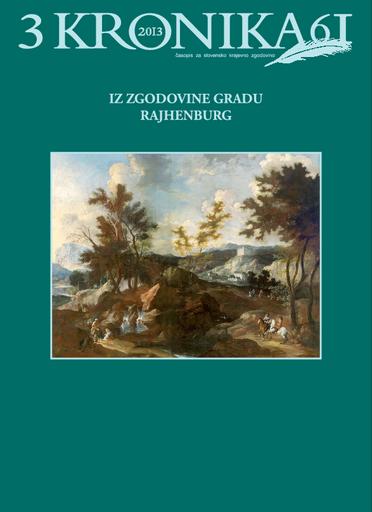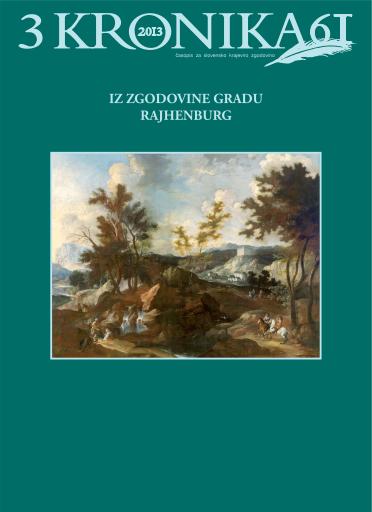/
Serijske publikacije
/
Kronika: časopis za slovensko krajevno zgodovino
Območje gradu Rajhenburg

Avtor(ji):Petra Jernejec Babič
Soavtor(ji):Miha Preinfalk (odg. ur.), Barbara Šterbenc Svetina (teh. ur.), Alenka Cizel (prev.), Manca Gašperšič (prev.), Andreja Jankovič Deržič (prev.), Dejan Zadravec (prev.), Lidija Slana (prev.), Meta Osredkar (prev.), Agencija MultiLingual (prev.), Irena Bruckmüller Vilfan (prev.)
Leto:2013
Založnik(i):Zveza zgodovinskih društev Slovenije, Ljubljana
Vir(i):Kronika, 2013, št. 3
Jezik(i):slovenščina
Vrst(e) gradiva:besedilo
Ključne besede:Rajhenburg, dediščinska kulturna krajina, zgodovinski park in vrt, spomeniško, Rajhenburg, cultural heritage landscape, historical park and garden
Avtorske pravice:

To delo avtorja Petra Jernejec Babič je ponujeno pod Creative Commons Priznanje avtorstva-Nekomercialno-Brez predelav 4.0 Mednarodna
Datoteke (1)

Ime:kronika-2013_3.pdf
Velikost:66.73MB
Format:application/pdf
Stalna povezava:https://hdl.handle.net/11686/file18349
Opis
Kulturni spomenik državnega pomena grad Rajhenburg pripada širšemu, prepoznavnemu, enovitemu in
topografsko določljivemu območju: kulturni krajini trajnih nasadov in območju nekdanjih vrtnih ureditev.
Poustvariti in revitalizirati je potrebno vse historične naravne in grajene prvine, saj so neločljivo povezane z
obnovljeno arhitekturo. Pri tem je potrebno upoštevati le preverljive zgodovinske podatke. Ostalin je malo,
vrtnoarhitekturni členi so uničeni ali poškodovani, zato o izvirni zasnovi ali stilnem obdobju ne moremo pisati.
Cilj celovite prenove območja gradu Rajhenburg je vzpostavitev urejene krajine gradu, ki je in mora ostati edina
prostorska dominanta.
Metapodatki (12)
- identifikatorhttps://hdl.handle.net/11686/35005
- naslov
- Območje gradu Rajhenburg
- Rajhenburg Castle area
- ustvarjalec
- Petra Jernejec Babič
- soavtor
- Miha Preinfalk (odg. ur.)
- Barbara Šterbenc Svetina (teh. ur.)
- Alenka Cizel (prev.)
- Manca Gašperšič (prev.)
- Andreja Jankovič Deržič (prev.)
- Dejan Zadravec (prev.)
- Lidija Slana (prev.)
- Meta Osredkar (prev.)
- Agencija MultiLingual (prev.)
- Irena Bruckmüller Vilfan (prev.)
- predmet
- Rajhenburg
- dediščinska kulturna krajina
- zgodovinski park in vrt
- spomeniško
- Rajhenburg
- cultural heritage landscape
- historical park and garden
- opis
- Kulturni spomenik državnega pomena grad Rajhenburg pripada širšemu, prepoznavnemu, enovitemu in topografsko določljivemu območju: kulturni krajini trajnih nasadov in območju nekdanjih vrtnih ureditev. Poustvariti in revitalizirati je potrebno vse historične naravne in grajene prvine, saj so neločljivo povezane z obnovljeno arhitekturo. Pri tem je potrebno upoštevati le preverljive zgodovinske podatke. Ostalin je malo, vrtnoarhitekturni členi so uničeni ali poškodovani, zato o izvirni zasnovi ali stilnem obdobju ne moremo pisati. Cilj celovite prenove območja gradu Rajhenburg je vzpostavitev urejene krajine gradu, ki je in mora ostati edina prostorska dominanta.
- The Rajhenburg Castle, a cultural monument of national importance, forms part of a broader, recognisable, homogeneous and topographically determinable area: a cultural landscape of permanent crops, with the centre formed by a complex of agricultural buildings and an area of former garden arrangements. All natural and built historical elements should be recreated and revitalised, as they are inseparably linked to the renovated architecture. This should be done by relying solely on verifiable historical data. The scarcity of remains, as well as ruined or damaged garden architectural elements, renders it impossible to write about any kind of original design or stylistic period. The goal of overall renovation of the Rajhenburg Castle area is to recreate the cultivated landscape of the castle, which has always been, and must remain, the only spatial dominant.
- Landscape architecture in the service of monument conservation deals with the theoretical and practical aspects of cultural landscape and garden architectural heritage (historical parks and gardens), which are among the less researched fields of cultural heritage in Slovenia. The Rajhenburg Castle, a cultural monument of national importance, forms part of a broader, recognisable, homogeneous and topographically determinable area: a cultural heritage landscape of permanent crops, with the centre formed by a complex of agricultural buildings and an area of former garden arrangements. The monument is considered within its spatial context, as a whole reflecting the social situation of a place through time. Today, it is no longer possible to detect any trace of a park or a garden within the core monument area: the structure of the area is blurred; the garden architectural elements are either ruined or damaged. Scanty archival documentation renders it impossible to write about any kind of original design or stylistic period. The presentation of the Rajhenburg Castle area can only be based on the available historical sources, written or graphical depictions indicating that it has always been recognised in scholarly circles as an important landscaped area. Somewhat more discernible are the extensions of agricultural buildings in the central part and the land plot structure, which has not been subject to considerable change. In addition to the renovated castle fortification, a presentation should also be made of the castle area as a cultivated castle landscape. There is a need to recreate and revitalise all natural and built historical elements, which are inseparably linked to the renovated architecture: the castle slope, the outer ward area, the decorative garden, the vegetable and herb garden, the monastery cemetery, the two treelined lanes. It is of vital importance that the castle remains the sole spatial dominant within the broader area, with the landscape arrangement subordinated to it. From the cultural conservation perspective, the monument site requires a balanced solution between protected qualities of the area and the development of the existing programme within the castle’s walls.
- založnik
- Zveza zgodovinskih društev Slovenije
- datum
- 2013
- tip
- besedilo
- jezik
- Slovenščina
- jeDelOd
- pravice
- licenca: ccByNcNd
